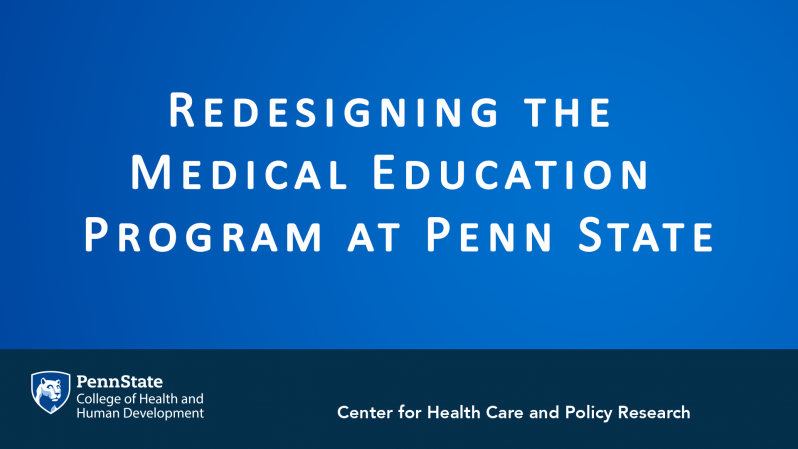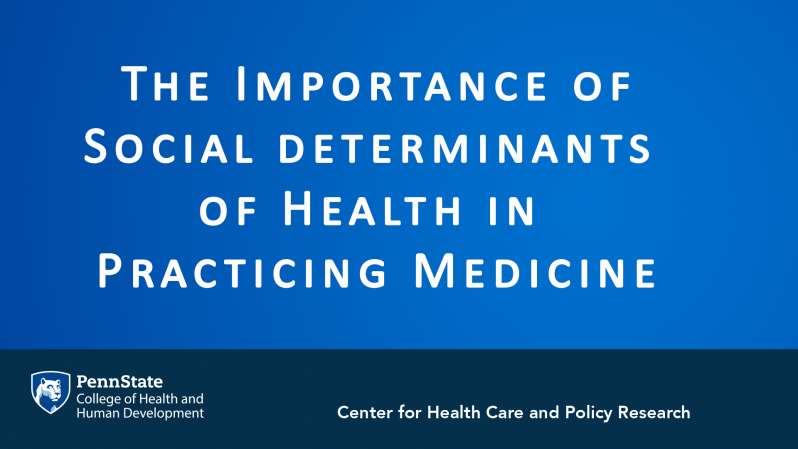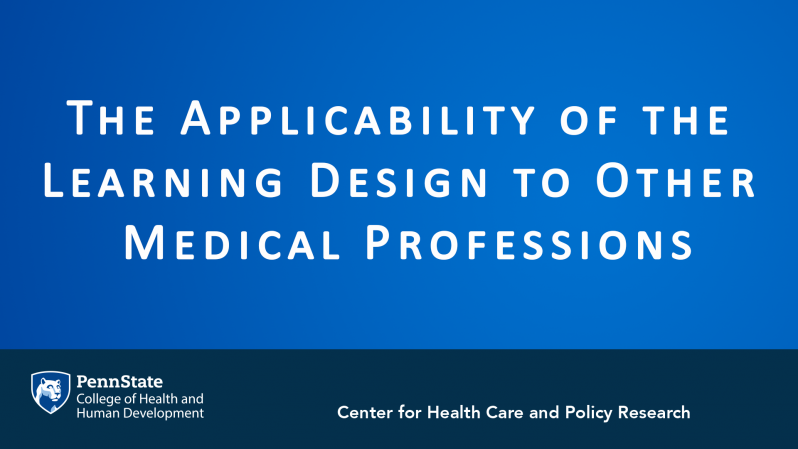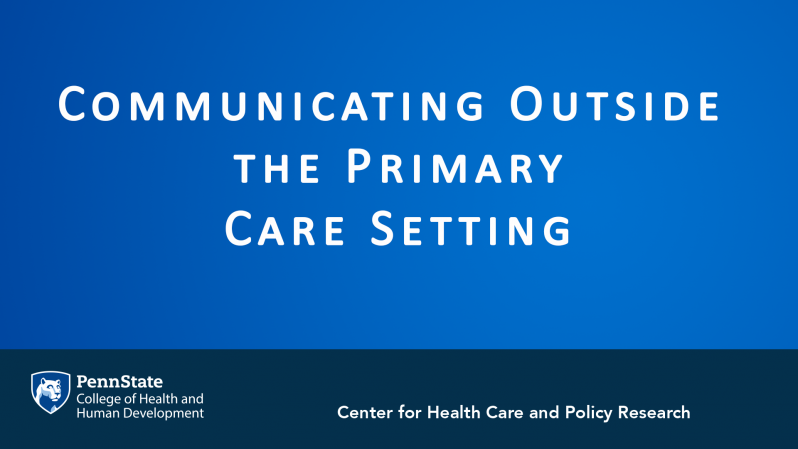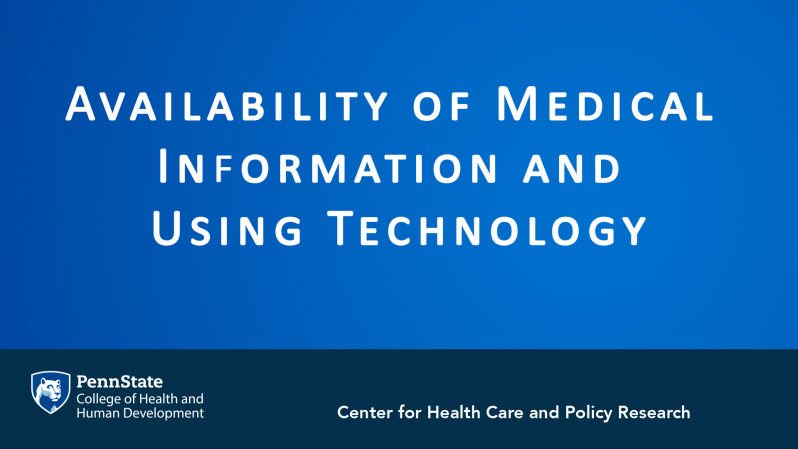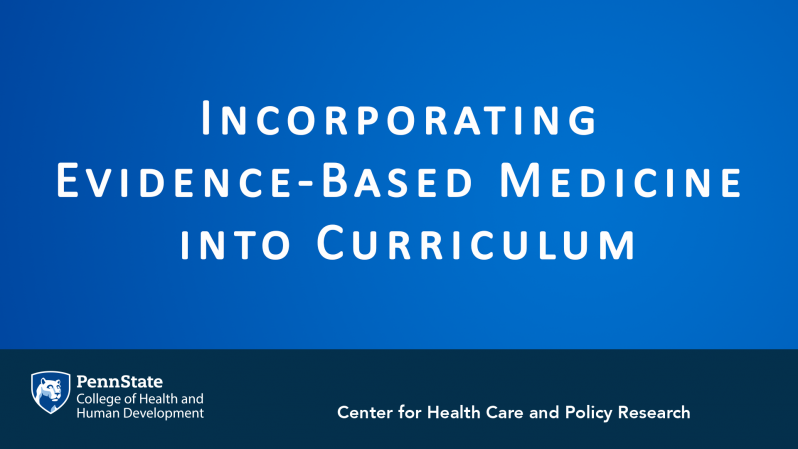Flipping the Traditional Medical School Training Model
Educating the Next Generation of Physicians
Ask the Experts
Jeffrey Wong, MD & Morgan Decker, University Park Regional Campus of Penn State College of Medicine
In this discussion of our “Ask the Experts” series, Dr. Dennis Scanlon speaks with Jeffrey Wong, MD, Associate Dean for Medical Education, and Morgan Decker, Medical Student Design Partner, University Park Regional Campus of Penn State College of Medicine to discuss an innovative medical education program at Penn State.
Interview Highlights
Redesigning the Medical Education Program at Penn State
Dr. Wong: “The thought behind putting together a new educational program stems from the notion that the way doctors practice in the 21st century is vastly different than the way they had been practicing in the previous century…Some of the skills that students need to have include working in interdisciplinary teams, they need to be able to access the information that is so readily obtainable…and be able to use that for their own decision making capacities.”
Dr. Wong: “There are a lot of different medical schools that are trying to rethink the way we teach medical education. I think the educational leadership at Penn State College of Medicine has been very forward thinking. The whole premise for doing this was actually based on a model from the Olin College of Engineering wherein they used students to help design their curriculum…a curriculum that was very experiential. Penn State, in a meeting with the Association of American Medical Colleges (AAMC) and the American Medical Association, tri-sponsored what they called an ‘Educational Summit’ in Washington, DC and brought thought leaders from all over North America to come and really grapple with this issue on how we should really train medical students for the future and it was from that meeting that a lot of the ideas have been implemented on this campus.”
External funding for the program
Dr. Wong: “Senator Jake Corman here in the Central part of Pennsylvania was able to be thinking about how we can create more positions for the center part of Pennsylvania, and his ability to bring in some money to support this campus has been really instrumental.”
What it means to be a ‘medical student design partner’
Morgan Decker: “A medical student design partner is a unique program that Penn State has sponsored in which students who were accepted to the Penn State College of Medicine...there are five of us…we are from all over, very different experiences, very different people, but we…decided to defer our medical education for one year and pilot and co-create what is the curriculum at University Park and then in July we will become part of the first class [at University Park]…a class size of 12. The reason that I chose this program… I was born and raised in Centre County, I am actually from Tyrone so to be able to train in the community that I am coming back to serve once I am done was definitely a highlight for me…There are other things about our curriculum such as the small class size, one-on-one mentoring, the culture that we developed that really attracted me to this particular program.”
Value of students in designing curriculum
Morgan Decker: “Part of what Olin [College of Engineering] did is they brought in students who had never been exposed to the engineering curriculum…the same concept we applied to this. We brought in new students, students who had never been in medical school with a fresh mind and new perspective.”
How this curriculum differs from traditional medical school
Dr. Wong: “The curriculum here at University Park is unique in that, rather than the students be directed in sequence by the teacher, by the syllabus, by some schedule, our curriculum will be driven by the individual students’ experiences. What that means is that the structure of the content is essentially developed on the fly. That is we don’t know what the students are going to see in their experiences and exposures. But they will take those exposures and bring those back and share them in a small group setting. The beauty of this structure, is that all of the learning and all of the investigation that goes on by the student is generated from his or her experiences and the learning is all done in the context of a real application.”
Resources required to deliver curriculum and scalability of the program
Dr. Wong: “The way that the teachers will interact with the students is quite a bit different. We would have a small number of faculty that meet with students very frequently in these small groups that we are calling inquiry groups and within these inquiry groups, the learning of all of those basic sciences…. as well as the clinical sciences…are fleshed out. There are two other pillars in the Penn State College of Medicine that are very important, looking at the systems in which these patients are receiving care…and the humanity of taking care of a patient and a patient’s family…We perceive and actually have tied into the curriculum the need to have other expertise in those areas going beyond what the individual mentors and teachers would be doing and tying that into the student learning is going to be part of the building process for the coming year. The second question about scalability is really important. We don’t know how that is going to work, but in some fashion the small group setting, the intimate knowledge with which the students and teachers will get to know one another will be really critical for this to work.”
Student design partners working with patients
Morgan Decker: “The first couple of months, our students will be in the clinic every day or every couple of days working with patients, whether its patient navigation…or more of a clerkship role, they are working with patients all the time…Our learning will be motivated in a different fashion. So there is the intrinsic motivation of ‘I really want to become a physician’…but there is also that extrinsic motivation, ‘I have a patient that I have responsibility for…’ If I would have gone to a traditional medical school…I would have read about diabetes in a book. Now, I am meeting patients with diabetes and so when I go home at the end of the day it’s not that I’m reading about diabetes so I that can take an exam. It’s I’m reading about diabetes, because I have a patient that I want to help navigate through this new diagnosis or current diagnosis. So I think the motivations are very different.”
Dr. Wong: “One of the forward thinking ideas that Penn State is ‘can we create a system that will allow us to train students in a very good way, but do it outside an academic medical center where most of [the future physicians] will be practicing and where most patients receive care.’ So Morgan’s notion of being part of the practice…but getting involved and becoming the medical student for this set of patients is really where we are driving this.”
The importance of social determinants of health in practicing medicine
Morgan Decker: “Two of our pillars are health systems science which is really the navigation through that very difficult system and then the humanities. I actually have, because I am from the area, I myself have experienced barriers in the health care system. I’m from a really small town where we only have a couple of doctors and a critical access hospital…so being able to really experience that in my own personal life has enhanced my experience here because I can empathize. I have patients that are no shows…and then when you call the patient…you realize they don’t have a ride…so being that we are training in the community, we are becoming these community trained physicians and recognizing that medicine goes beyond the basic clinical sciences, medicine is the person, medicine is who they are and what they enjoy and incorporating that health system sciences and humanities is very important.”
Dr. Wong: “The experiential curriculum that these young people are going through is the best way to teach them social determinants. You can talk about them in a lecture, but again it is out of context. If they are actually working with people day in and day out who are having these barriers come up…there is no better way to do that.”
Is the profession ready for this new model of medical education?
Dr. Wong: “There is no doubt in our minds that it is a difficult sell. Some of the job of Morgan and her colleagues this year was to do some of that training…This is not a model that anyone is familiar with…so to try to get people to buy into the importance of it is a continual campaign. The whole change notion of getting people on board, to see the benefits of this model, is something that is going to continue to play out over time. Fortunately we have five incredible young people…helping to change minds one physician at a time.”
Applicability of the learning design to other medical professions
Morgan Decker: “It is hard to think of people who aren’t a part of our team…this entire year we have had our faculty, and of course our colleagues and those within the clinics so the providers, but often times I found myself with people who work at the front desk, I found myself with nurses, with others providers, physician assistants and nurse practitioner as part of our team, but we also have patients who are part of our team…other community members have been part of our team…a lot of people contribute in some way.”
Dr. Wong: “I don’t know personally the details of nurse practitioner and physician assistant programs, but given what I believe is a really good way of training people, that is training them in the context of which they will be practicing, I don’t think there is any downside to doing it…but the model itself ought to work for that kind of training or for any sort of training where you actually have to work within systems.”
Communicating outside of the primary care setting
Morgan Decker: “Our home base is really in a primary care office…and a lot of our patients do have specialists that they do follow up with. As far as communication is concerned, I haven’t experienced a lot of communication difficulty between providers. I have experienced them between different organizations…Part of that is really the system that we are using to transfer information, and part of it is everyone is really busy.”
Availability of medical information and using technology
Dr. Wong: “If you’re trying to be plain about it, the model of the past century of medical education, the onus was on the schools and teachers of the schools to deliver a lot of content…and information to students…I think that is much less important now, I think it is much more important for us to be able to train students how to get the information, how to use it, how to weed out what is important and what isn’t important and to really be able to do critical thought about what is out there.”
Morgan Decker: “All of the health systems [in this region] use a different electronic health record (EHR), so oftentimes if they have a different EHR they may not be compatible with the specialist office that may be in a different health system…So all of our students will train on these EHRs so that they can access patient records, but then trying to get that information to another office that may have a different record…it’s something because we are in the clinic so often we are exposed to day in and day out.”
Benefits of the Regional Campus
Dr. Wong: “Up until recently, there has always been this attempt for the Hershey campus and the Penn State University Park campus to come together to try to collaborate and I think with the Regional Campus here and having medical students now starting in their first year of medical school, the opportunities are really existing to build that and to expand that. Morgan has done a lot of work herself meeting people on the University Park campus in different colleges that would be interested in trying to build up collaborative relationships with the medical school, both for the students here and back to folks working in Hershey.”
Incorporating evidence-based medicine into curriculum
Morgan Decker: “A lot of medical schools are doing…evidence-based medicine, so really understanding how to read a paper, understand a paper, take those findings and apply them…the discussions we are having in a small group setting…we are able to tackle questions like that. We talked a lot about guidelines…for particular types of screenings…what is known and what should be done…and that is one of the best things about our campus is we have created this culture where it is okay to ask any questions…we have those conversations…and what is the evidence surrounding it.”
Evaluating the success of this program
Dr. Wong: “There are lots of potential different ways of evaluating this…We are all looking at ways to make medical education less expensive…and more pertinent to the populations for whom the doctors will care. And were we able then to create evaluative measures of those sorts of things, that would be a good place to start…And were we able to measure the community’s engagement in embracing medical education as part of what they need to do would also be a very novel, but important, outcome measure to have.”

